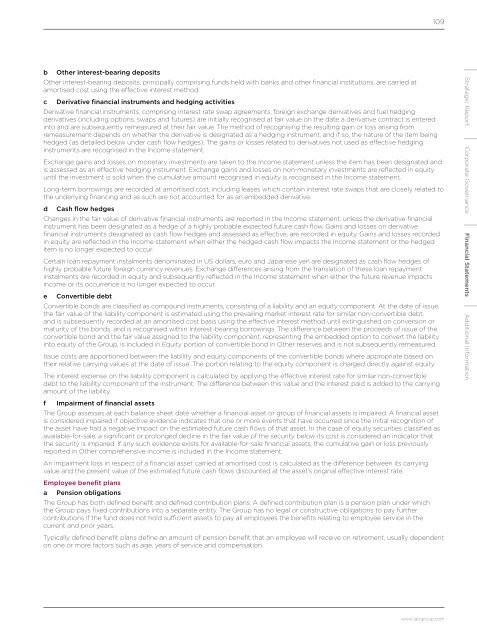Annual report and accounts 2016
You also want an ePaper? Increase the reach of your titles
YUMPU automatically turns print PDFs into web optimized ePapers that Google loves.
109<br />
b<br />
Other interest-bearing deposits<br />
Other interest-bearing deposits, principally comprising funds held with banks <strong>and</strong> other financial institutions, are carried at<br />
amortised cost using the effective interest method.<br />
c Derivative financial instruments <strong>and</strong> hedging activities<br />
Derivative financial instruments, comprising interest rate swap agreements, foreign exchange derivatives <strong>and</strong> fuel hedging<br />
derivatives (including options, swaps <strong>and</strong> futures) are initially recognised at fair value on the date a derivative contract is entered<br />
into <strong>and</strong> are subsequently remeasured at their fair value. The method of recognising the resulting gain or loss arising from<br />
remeasurement depends on whether the derivative is designated as a hedging instrument, <strong>and</strong> if so, the nature of the item being<br />
hedged (as detailed below under cash flow hedges). The gains or losses related to derivatives not used as effective hedging<br />
instruments are recognised in the Income statement.<br />
Exchange gains <strong>and</strong> losses on monetary investments are taken to the Income statement unless the item has been designated <strong>and</strong><br />
is assessed as an effective hedging instrument. Exchange gains <strong>and</strong> losses on non-monetary investments are reflected in equity<br />
until the investment is sold when the cumulative amount recognised in equity is recognised in the Income statement.<br />
Long-term borrowings are recorded at amortised cost, including leases which contain interest rate swaps that are closely related to<br />
the underlying financing <strong>and</strong> as such are not accounted for as an embedded derivative.<br />
d Cash flow hedges<br />
Changes in the fair value of derivative financial instruments are <strong>report</strong>ed in the Income statement, unless the derivative financial<br />
instrument has been designated as a hedge of a highly probable expected future cash flow. Gains <strong>and</strong> losses on derivative<br />
financial instruments designated as cash flow hedges <strong>and</strong> assessed as effective, are recorded in equity. Gains <strong>and</strong> losses recorded<br />
in equity are reflected in the Income statement when either the hedged cash flow impacts the Income statement or the hedged<br />
item is no longer expected to occur.<br />
Certain loan repayment instalments denominated in US dollars, euro <strong>and</strong> Japanese yen are designated as cash flow hedges of<br />
highly probable future foreign currency revenues. Exchange differences arising from the translation of these loan repayment<br />
instalments are recorded in equity <strong>and</strong> subsequently reflected in the Income statement when either the future revenue impacts<br />
income or its occurrence is no longer expected to occur.<br />
e Convertible debt<br />
Convertible bonds are classified as compound instruments, consisting of a liability <strong>and</strong> an equity component. At the date of issue,<br />
the fair value of the liability component is estimated using the prevailing market interest rate for similar non-convertible debt,<br />
<strong>and</strong> is subsequently recorded at an amortised cost basis using the effective interest method until extinguished on conversion or<br />
maturity of the bonds, <strong>and</strong> is recognised within Interest-bearing borrowings. The difference between the proceeds of issue of the<br />
convertible bond <strong>and</strong> the fair value assigned to the liability component, representing the embedded option to convert the liability<br />
into equity of the Group, is included in Equity portion of convertible bond in Other reserves <strong>and</strong> is not subsequently remeasured.<br />
Issue costs are apportioned between the liability <strong>and</strong> equity components of the convertible bonds where appropriate based on<br />
their relative carrying values at the date of issue. The portion relating to the equity component is charged directly against equity.<br />
The interest expense on the liability component is calculated by applying the effective interest rate for similar non-convertible<br />
debt to the liability component of the instrument. The difference between this value <strong>and</strong> the interest paid is added to the carrying<br />
amount of the liability.<br />
f Impairment of financial assets<br />
The Group assesses at each balance sheet date whether a financial asset or group of financial assets is impaired. A financial asset<br />
is considered impaired if objective evidence indicates that one or more events that have occurred since the initial recognition of<br />
the asset have had a negative impact on the estimated future cash flows of that asset. In the case of equity securities classified as<br />
available-for-sale, a significant or prolonged decline in the fair value of the security below its cost is considered an indicator that<br />
the security is impaired. If any such evidence exists for available-for-sale financial assets, the cumulative gain or loss previously<br />
<strong>report</strong>ed in Other comprehensive income is included in the Income statement.<br />
An impairment loss in respect of a financial asset carried at amortised cost is calculated as the difference between its carrying<br />
value <strong>and</strong> the present value of the estimated future cash flows discounted at the asset’s original effective interest rate.<br />
Employee benefit plans<br />
a Pension obligations<br />
The Group has both defined benefit <strong>and</strong> defined contribution plans. A defined contribution plan is a pension plan under which<br />
the Group pays fixed contributions into a separate entity. The Group has no legal or constructive obligations to pay further<br />
contributions if the fund does not hold sufficient assets to pay all employees the benefits relating to employee service in the<br />
current <strong>and</strong> prior years.<br />
Typically defined benefit plans define an amount of pension benefit that an employee will receive on retirement, usually dependent<br />
on one or more factors such as age, years of service <strong>and</strong> compensation.<br />
Strategic Report Corporate Governance Financial Statements Additional Information<br />
www.iairgroup.com



